二语习得论文
- 格式:doc
- 大小:30.50 KB
- 文档页数:5
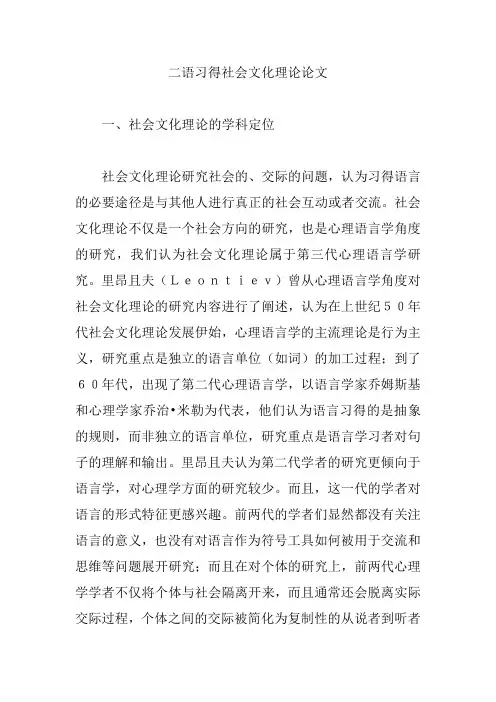
二语习得社会文化理论论文一、社会文化理论的学科定位社会文化理论研究社会的、交际的问题,认为习得语言的必要途径是与其他人进行真正的社会互动或者交流。
社会文化理论不仅是一个社会方向的研究,也是心理语言学角度的研究,我们认为社会文化理论属于第三代心理语言学研究。
里昂且夫(Leontiev)曾从心理语言学角度对社会文化理论的研究内容进行了阐述,认为在上世纪50年代社会文化理论发展伊始,心理语言学的主流理论是行为主义,研究重点是独立的语言单位(如词)的加工过程;到了60年代,出现了第二代心理语言学,以语言学家乔姆斯基和心理学家乔治•米勒为代表,他们认为语言习得的是抽象的规则,而非独立的语言单位,研究重点是语言学习者对句子的理解和输出。
里昂且夫认为第二代学者的研究更倾向于语言学,对心理学方面的研究较少。
而且,这一代的学者对语言的形式特征更感兴趣。
前两代的学者们显然都没有关注语言的意义,也没有对语言作为符号工具如何被用于交流和思维等问题展开研究;而且在对个体的研究上,前两代心理学学者不仅将个体与社会隔离开来,而且通常还会脱离实际交际过程,个体之间的交际被简化为复制性的从说者到听者的信息转移,即说者输出的信息,会被听者以完全一样的形式理解;第三代心理语言学研究则更加倾向于心理学研究,对语言学方面的研究相对较少,研究焦点也从原来的对句子、文本的理解和加工转移到了交际和思维过程的心理学分析。
第三代心理语言学并不是对服务于言语行为的心理结构的实现进行研究,而是探索在活动中使用语言(作为工具)的不同策略进行研究。
当活动的目的是对他人产生影响的时候,活动即为交际性的;当活动的目的是对自身产生影响的时候,活动即为认知性的。
两种活动是相辅相成、辩证性存在的,因此从一开始就有必要对二者进行管理。
也就是说,自我导向的言语活动,来源于他人导向的言语活动,在本质上二者都是交际形式的一种。
将交际活动优先于对抽象性语言规则加工过程的习得进行研究,使第三代心理语言学将言语(和书面语言)对人类具体的社会和思维活动的调节作为研究重点,认为言语活动是有动机性和目的性的。
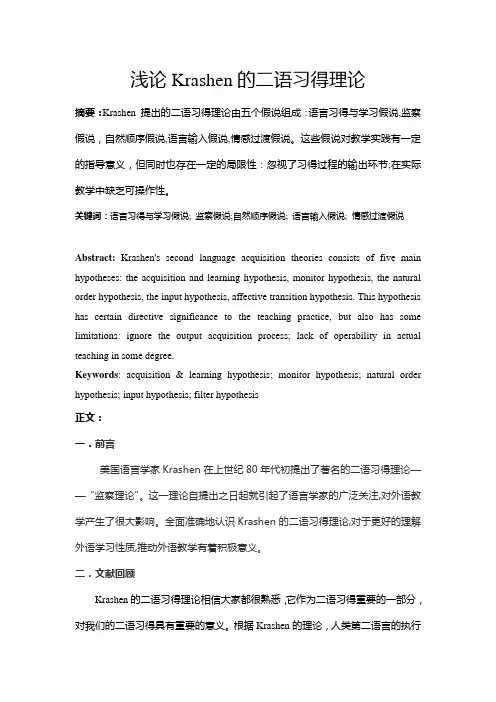
浅论Krashen的二语习得理论摘要:Krashen 提出的二语习得理论由五个假说组成:语言习得与学习假说,监察假说,自然顺序假说,语言输入假说,情感过渡假说。
这些假说对教学实践有一定的指导意义,但同时也存在一定的局限性:忽视了习得过程的输出环节;在实际教学中缺乏可操作性。
关键词:语言习得与学习假说; 监察假说;自然顺序假说; 语言输入假说; 情感过渡假说Abstract:Krashen's second language acquisition theories consists of five main hypotheses: the acquisition and learning hypothesis, monitor hypothesis, the natural order hypothesis, the input hypothesis, affective transition hypothesis. This hypothesis has certain directive significance to the teaching practice, but also has some limitations: ignore the output acquisition process; lack of operability in actual teaching in some degree.Keywords: acquisition & learning hypothesis;monitor hypothesis;natural order hypothesis;input hypothesis;filter hypothesis正文:一.前言美国语言学家Krashen在上世纪80年代初提出了著名的二语习得理论——“监察理论”。
这一理论自提出之日起就引起了语言学家的广泛关注,对外语教学产生了很大影响。
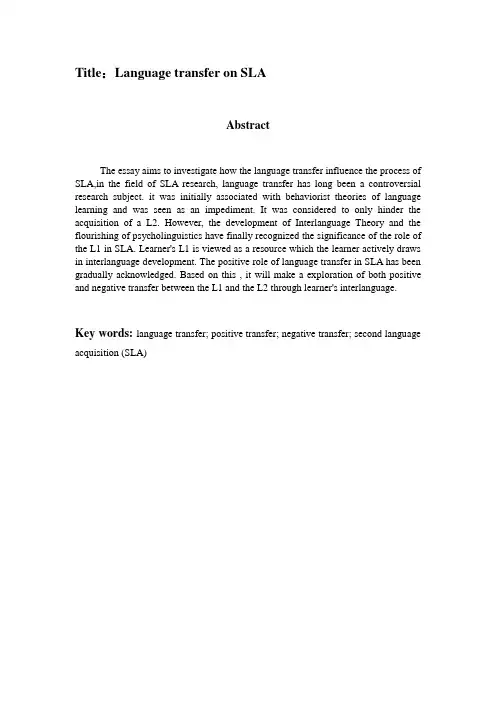
Title:Language transfer on SLAAbstractThe essay aims to investigate how the language transfer influence the process of SLA,in the field of SLA research, language transfer has long been a controversial research subject. it was initially associated with behaviorist theories of language learning and was seen as an impediment. It was considered to only hinder the acquisition of a L2. However, the development of Interlanguage Theory and the flourishing of psycholinguistics have finally recognized the significance of the role of the L1 in SLA. Learner's L1 is viewed as a resource which the learner actively draws in interlanguage development. The positive role of language transfer in SLA has been gradually acknowledged. Based on this , it will make a exploration of both positive and negative transfer between the L1 and the L2 through learner's interlanguage. Key words: language transfer; positive transfer; negative transfer; second language acquisition (SLA)nguage transfer1.1Definitions of language transferLanguage transfer took its root in the Transfer Theory in psychology. Psychologists defined ' transfer' as a type of learning activities by which learners' previously acquired knowledge about the learning skills will influence the out come of their learning or training behavior. They maintain that transfer can be both be both positive and negative.Behaviorists defined transfer as a consequence of habit formation, which implies the extinction of the learner's primary language when he or she is learning the new language.However, it is now widely accepted that the influence of the learner;s native language cannot be adequately accounted for in terms of habit formation. Nor is transfer simply a matter of interference or of falling back on the native language. Nor is it just a question of the influence of the learner's native language, as other previously acquired 'second' languages can also have an effect (Ellis, 1994). This suggests that the term ' L1 transfer' itself is inadequate. Some scholars have advocated abandoning the term or using it in highly restricted ways. Sharwood and Kellerman (1986) have argued that a superordinate term that is theory-neutral is needed and suggest crosslinguistic influence. They comment:the term 'crosslinguistic influence' is theory-neutral, allowing one to subsume under one heading such phenomena as 'transfer', 'interference', 'avoidance', 'borrowing' and L2-related aspects of language loss and thus permitting discussion of the similarities and differences between these phenomena.(1986:1)Odlin(1989) offers this ' working definition' of transfer as basis for his own thoughtful treatment of such pehenomena: transfer is the influence resulting from the similarities and the differences between the target language and any other language that has been previously acquired91989;27).Many researchers disapprove of the term "language transfer", and prefer "mother tongue influence" proposed by Corder (1983)or "cross-linguistic influence" by Kellerman instead. However, we will stick to the term "language transfer" throughout this thesis, partly because of its convenience, and partly because of its familiarity to most people, with the understanding that here "Language transfer" is used in its broad sense, not restricted to the behaviorist notion.1.2The manifestations of Language TransferIn traditional accounts of language transfer, the research focus was placed on the errors that learners produce. Errors occurred as a result of the negative transfer of mother tongue patterns into learn's L2 (Ellis, 1994). It is possible to identify a number of other manifestations of transfer however, three of which are frequently discussed by transfer researchers:negative transfer,positive transfer.1.2.1.Negative transfer(errors)Negative transfer, also known as interference, is the use of a L1 pattern or rule which heads to an error or inappropriate form in the L2. Negative transfer can befound at all the levels of language structure. A speaker's foreign accent in L2 learning is an evidence of negative transfer at the phonological level. Morphological negative transfer is common. For instance, under the influence of Chinese language, some students will say "big rain" rather "heavy rain". Negative transfer at syntactical level also exists. For example, when a learner is asked to translate the sentence " 我昨天在家做作业" into English, he or she tends to ignore the tense and word order of an English sentence and would translate it according to the Chinese grammatical structure " I yesterday at home do homework".1.2.2.Positive transfer (facilitation)Positive transfer is transfer which makes learning easier, and may occur when both the L1 and L2 have the same form. Similarities between vocabulary can reduce the time needed to develop good reading comprehension; similarities between vowel systems can make the identification of vowel sound easier; similarities between writing systems can give learners a fast starting in reading and writing the L2; and similarities in syntactic structures can facilitate the acquisition of grammar. For example, when a learner is asked to translate the sentence "我说汉语" into English, he or she can translate it correctly with the help of his or her L1 "I speak Chinese" because the basic word order of both Chinese and English is S(subject)+ V (verb or predicate) + O (object).So , positive transfer is beneficial while negative transfer is a hindrance to SLA. From the above discussion, we can see it is clearly insufficient to focus exclusively on production errors, since transfer is a complex phenomenon which involves not only L1 knowledge but also other factors that interact with L1 knowledge.2.The Historical Development and Recent Situation of the Study on LanguageTransfer in SLALanguage transfer has exerted considerable effect on SLA. People in the past have conducted detailed investigation and research on transfer phenomena in learning a L2. From the historical point of view, the research of language transfer in SLA has undergone three stages.2.1. Domination of Behaviorist Point of ViewEarly language transfer research can be traced back to the 1940s and 1950s. The first two influential people who systematically studied the role of language transfer in SLA were Charles C. Fries and Robert Lado. Fries (1945) put forward the issue from the angle of the compilation of teaching materials. He formulated the need for contrastive analyses through observations. He states that the most efficient materials are those based upon a scientific description of the language to be learned, carefully compared with a parallel description of the native language of the learner.(1945:9). Robert lado proposed a potentially rigorous model, Contrastive Analysis Hypothesis(CAH) (Lado.1957), which was based on this assumption: the student who comes into with a foreign language will find some features of it quite easy and others extremely difficult. Those elements that are similar to his native language will be simple for him, and those elements that are different will be difficult.(1957:2)During 1950s, behaviorist behaviorist views of language learning and language teaching were predominant. Language transfer was always integrated with behaviorism, and thus became the theoretical basis of comparative analysis. For one thing, the behaviorist notions of transfer often implies the extinction of early habits, whereas the acquisition of a L2 need not lead to any replacement of the learner's primary language. This and other considerations suggest that behaviorism may never have been relevant to the study of transfer (Odlin, 1989).2.2.Prevalence of Mentalist Point of ViewFrom the late 1960s to the 1970s , the behaviorist point of view was severely criticized due to the influence caused by Chomsky's linguistic theory. Chomsky (1965) advocates a strong version of the innateness hypothesis. He argues that children are born with a specific and unique kind of knowledge which equips them for language learning. This knowledge is embodied in a mechanism called a language acquisition device (LAD). He believes that a child must be predisposed to learn any language as a native language and that the LAD must contain language universals. He then seeks to identify linguistic universals by the in-depth study of a single language. He argues that only in this way is it possible to discover the highly abstract principles of grammar that constrain the form of any specific grammar. He refers to these principles as Universal Grammar. While Greenberg (1966) and some followers establish universals by examining a wide range of languages from different language families in order to discover what features they have in common, which are referred to as typological universals. Therefore, followeing Chomsky's attack on behaviorism, its drawbacks were exposed gradually and the function of language transfer was largely held in contempt in SLA. Both behaviorism and transfer phenomena were treated coldly and ignored, and the role of L1 was played down. This minimalist view of L1 transfer, however, has not withstood the test of time (Ellis, 2000).2.3.Influence of Cognitive Point of ViewDuring the mid-to-late 1970s, the emphasis was on the determination of how and wehn learners used their L1 and on explanations for the phenomena. Little by little, the study of language transfer has come into a cognitive period. The word ' language transfer ' did not merely refer to the meachanical transfer from L1 to L2. It was treated as a kind of important learning strategy in SLA, a complicated cognitive procedure that is influenced by various factors. Ellis (1994) points out that one clear advance in transfer research has been the reconceptualizaton of the influence of the L1;in behaviorist accounts it was seen as impediment, whereas in cognitive accounts it is viewed as a resource which the learner actively draws in interlanguage development. The positive role of language transfer in SLA has gradually been acknowledged.nguage transfer in SLAIt is a popular belief that second language acquisition (SLA) is strongly influenced by the learner's first language (L1). The clearest support for this belief comes from "foreign" accents in the second language (L2) speech of learners (Ellis, 1985). When a French man speaks English, his English sounds French. When a Chinese speaks English, his English sounds Chinese. In addition to accents, L1 habits also influence the way learners use to express themselves in L2. For example, such Chinese expression as "*department company"(department store 百货公司), "*family computer" (personal computer 家用电脑) can often be heard (陆效用,2002). Furthermore , there are lots of Chinglish expression in the syntactical level, for instance, "我昨天在家做作业" would be translated into English according to the Chinese grammatical structure "*Iyesterday at home do homework". ( I did my homework at home yesterday.) as far as thinking mode is concerned, Chinglish sentences "*His body is very healthy" (He is very healthy) and "* Good good study, day day up" (If you study hard, you will make progress very day) are highly likely to be produced by Chinese learners of English. Common Chinese greetings around meal time "吃了吗?" "Have you eaten yet?" or "Have you had your lunch?" would be transfered when Chinese learners of English meet native-speaker of English. All these phenomena all show how language transfer influence second language acquisition.Traditional linguistics holds that the role of the L1 in SLA is a negative on (陆效用,2002). That is , the L1 gets in the way or interferes with the learning of the L2, such that features of the L1 are transferred into the L2 (Ellis, 1985). For years, most experts and language teachers have emphasized negative transfer in SLA, and neglected the positive role of the L1. In L2 teaching , therefore, they are strongly opposed to the use of L1.Do L1 really play only a negative role in SLA? Does it only hinder the acquisition of a L2? Is there any positive transfer in SLA? Can L1 also benefit the acquisition of a L2? In L2 teaching, can L1 be used?In our opinion, the so-called L1 negative influence hypothesis or L1 interference hypothesis is one-sided, it neither reflects the nature of language learning nor reveals the inner relationship between L1 and SLA. Taken the above Chinglish expressions for example, superficially, the L1 does influence the L2 expressions, but in fact, it is the L1 that helps the learner finish the communicative task. In the process of SLA, especially in the early stages of proficiency, learners have to fall back on their L1 knowledge in case of emergency in order to communicate effectively. This is a "cognitive process", "a learner's strategy", and also a necessary process in SLA(陆效用,2002).As a matter of fact, in the field of SLA research, language transfer has lonog been a controversial research subject, especially the influence of learner's L1 on L2. Generally speaking, the research of language transfer in SLA has undergone three stages. In the 1950s, it was seen as an impediment and was deemed as playing an important role in L2 learning when Lado's Contrastive Analysis Hypothesis dominated the field. Language transfer was considered to only hinder the acquisition of a L2. With the popularity of the Chomskyan Universal Grammar which denies the existence of transfer phenomena, the researchers' interest in language transfer has declined since the 1960s,and language transfer was regarded as playing a minor role in the process of SLA. However, the development of Interlanguage Theory and the flourishing of psycholinguistics have finally recognized the significance of the role of the L1 in SLA. Learner's L1 is viewed as a resource which the learner actively draws in interlanguage development. The positive role of language transfer in SLA was gradually acknowledged. As a result, the role of the L1 is not only a negative one but also a positive one; it does not only interfere with the learning of the L2 but also facilitate the learning of the L2.3.1Phonetic transferPhonetic transfer occurs when the learner tends to transfer similar but phonologically different sounds of his or her L1 to those of the L2. It can be both positive and negative resulting from the learner's conventional habit of articulation. 3.1.1.PhonemeIt is known that the Chinese phonetic alphabet is divided into three categories: sehngmu, yunmu and diaozi. A shengmu is equivalent to consonant and a yunmu to a vowel. What often happens is that those who have systematically learned the Chinese phonetic alphabet are good at taking in English phonetic knowledge because most English phonemes have similar counterparts in Chinese and thus quite a number of Chinese pronouncing skills can be transferred into pronouncing English phonemes.For example, the beginning shengmu [k, t , m , l ] in Chinese words "开头" "美丽" are equivalent to English consonants [ k , t , m, l ]; and the yunmu [ai, ou, ei ,i ] have their counterparts in English. Look at some English words: kite [kait], toe [təu], make [meik], lead [li:d]. All of these are similar to the Chinese pinyin.Similarity between the phonemes of the two languages has double functions. On the one hand , it causes generalization in listening and pronouncing English words, which, in turn, makes students mistankenly treat the similarity between the phonemes as being identical, and substitute Chinese phonemes for English ones, resulting in the negative transfer of L1. On the other hand, oweing to the existence of some regularities that govern the differences between the two phonetic systems, it is a very useful step to perfect English pronunciation for most Chinese learners of Englsih. Once the student realizes these regularities through elaborate language comparison and becomes skilled in using them, he or she will soon be able to adapt his or her L1 pronouncing skills and pronounce English phonemes correctly, hence forming the positive transfer of L1. For example , with their vowel component [ə] removed, the Chinese initial consonants b, p, m , f , v , d, t, n , l, g , k, b, s , w, g, ŋ are very similar to English consonants [b], [p], [m], [f], [v], [d], [t], [n], [l], [g ], [k], [h], [s],[w], [ŋ]. This regularity is a very useful step to perfect English pronunciation for most Chinese learners of English. It greatly shortens the natural process of discrimination, which, in ordinary situations, is rather long. Its value may be assessed readily if we point out that quite a few Chinese learners of English fail to discern the difference.Accounting for one third of the total English phonemes, the above 15phonemes may constitute a great deal of negative transfer of L1 when not corrected, or a lot ofpositive transfer of L1 when corrected. Here lies a vast potentiality to save time and energy in SLA.This example indicates that the role of L1 in SLA is not fixed and consistent but changeable, sometimes helps, sometimes hinder. It also shows that phoneme comparison helps to turn the task into an easy one. Moreover, this comparison also enables us to deepen our understanding of our native language---Chinese.Usually, a native speaker of Chinese hardly ever thinks of studing phonetic structure of his mother tongue. Now that he is engaged in leaning English, he sees that the 15 Chinese phonemes have counterparts in English. Whenever he sees one of the contrastive phonemes, he will immediately think of the other. This kind of contrastive association is certainly very conductive to strengthening memory and comprehension of both languages concerned. Hence this example may be regarded as one showing the reversed positive transfer from L2 to L1.Not every English phoneme has a counterpart in Chinese. A few English phonemes have no counterparts in Chinese. For example, the two English dental sound [ө] is utterly new, thus very troublesome to Chinese learners. Beginning learners tend to replace the sound with approximate Chinese sounds [s] and [z] or [d ]. Some learners fail to discern the two in listening and speaking even after many years' learning.There is a phenomenon of consonant clusters in English. Furthermore, there are words ending in vowel of open syllables and there also exist words ending in consonants of close syllables in the English vocabulary. However, most Chinese characters are monosyllables. When beginning learners read a word beginning or ending with consonant clusters, or when they read an English close syllable subconsciously, they often insert a 'support' vowel sound between the consonants or add a vowel sound at the end of a word. So these are typical negative phonetic transfers in acquiring English.Phonetic negative transfer resulting from English learning is usually very hard to overcome. Even though the learning environment is favorable, and the learner is hard working, his pronunciation cannot be improved to be as perfect as that of the native English sperker. That's why when a French man speaker English, his English sounds French; when a Chinese speaker English, his English sounds Chinese. Therefore, phoneme comparison should be overemphasized at elementary stage so as not to cause too much negative transfer at the beginning of the study.3.1.2IntonationThere exists such a general phenomenon is every language as the falling intonation, which is used basically to express definiteness and completeness, the rising intonation, which expresses suspicion and incompleteness and the blending intonation, which appears with double sides o fpsychology(Danicoff,1980) and is mainly used to express complex feelings.Meaning of intonation patterns in Chinese and English are similar, the falling intonation is more often associated with definiteness, completeness and assertiveness while the rising intonation is more is more often associated with incompleteness, uncertainty and tentativeness. It suggests that something further must be said either bythe speaker or by the hearer. It is also often accompanied with politeness, encouragement, pleading, diffidence or suspicion. The blending intonation expresses feelings of hesitation, contrast, reservation, or doubt. The implication is sometimes that the speaker hesitate to make his statement too confidently, and at other times it conveys a warning or an apology. Intonation helps to produce the effect of prominence on syllables that need to be perceived as stressed, and in particular the placing of tonic stress on a particular syllable marks out the word to which it belongs as the most important in the tone-unit. Both Chinese and English have such kind of intonation function.most Chinese learners of English have no difficulty in mastering these basic English intonation patterns and their functions. Here, their habitual modes and skills of expressing and thinking formed in previous native language learning can be transferred into Engish learning. This is the favorable side of English intonation learning, where positive transfer of Chinese plays an important role.Nevertheless, the negative transfer of L1 exists here too, which is rather hard to conceive. Chinese is a tone language, it is the kind of language which uses tone to distinguish word meaning while English, an intonation language which uses tone to distinguish word meaning while English, an intonation language, is the kind of language which employs intonation to distinguish the meaning while English, an intonation language, is the kind of language which employs intonation to distinguish the meaning of pared with the relatively smooth and simple intonations of Chinese, English intonation vary in large pitch amplitude and more sophisticated patterns.3.1.3.Syntactical transferSyntactical transfer involves the transference of syntactic structures, such as word order, modification devices, articles, the number, the gender, relative clause and so on ,it can be both positive and negative.Word orderIn some cases, the word order of seven types of simple sentences in English is similar to those in Chinese.1.SV structure2.SVC structure3..SVO structure4..SVOO structure5.SVOC structure6.SVOA structure7..SV A structure4.ConclusionIt is a fact that language transfer exists at all the levels of language structure. From this ,we have found that the mechanism of L1's function in SLA is very complicated, there seldom exists pure positive or negative transfer in the process.we would not be able to exploit fully its positive side unless we profound study in language comparison and mechanism of transfer. We are sure that more example will be found to show that L1 promotes L2 acquisition.BibliographyBrown, H. D. Principles of Language Learning and Teaching. New York: Prentice Hall Regents, 1994.Chomsky, N . Aspects of the Theory of Syntax. Cambridge, 1965Cook, vivian. Linguistics and Second Language Acquisition. Beijing: Foreign Language Teaching and Research Press, 2000.Corder, S.P. The Significance of Learners' error.[J]. IRAL, 5, 161-170, 1967 Eckman, F.R. Markedness and the Conrastive Analysis Hypothesis[J]. Language Learning 27,315-30,1997Ellis, Rod. Understanding Second Language Acquisition. Shanghai: Shanghai Foreign Langugae Education Press,1986.Ellis, Rod. Second Language Acquisition. Shanghai; Shanghai Foreign Language Education Press, 2000Fries, C. Teaching and Learning English as a Foreign Language. Ann Arbor: The University Michigan Press,1945.Greenberg, W. Universals of Language. Cambridge,: MIT Press, 1966.Kellerman E, An eye for an eye :corsslinguistic constraints on the development of the L2 lexicon,1986Odlin, Therence. Language Transfer- Cross-linguistic Influence in Language Learning. Shanghai: Shanghai Foreign Language Education Press. 2001.陆效用.试论母语对二语习得的正面影响[J].外语界,2002.(4)。
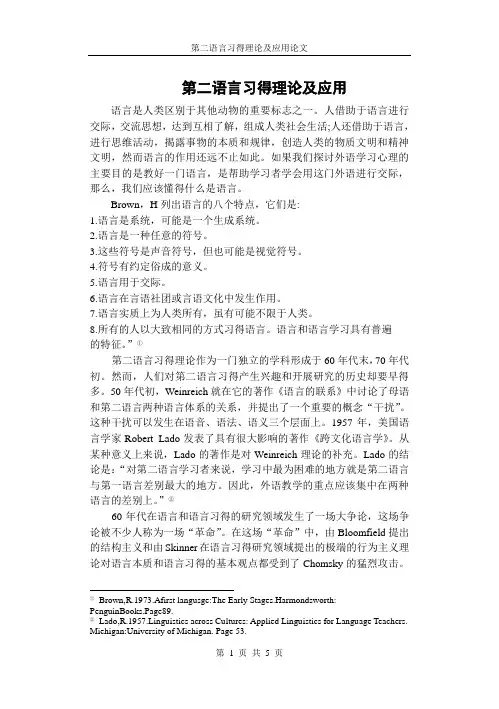
第二语言习得理论及应用语言是人类区别于其他动物的重要标志之一。
人借助于语言进行交际,交流思想,达到互相了解,组成人类社会生活;人还借助于语言,进行思维活动,揭露事物的本质和规律,创造人类的物质文明和精神文明,然而语言的作用还远不止如此。
如果我们探讨外语学习心理的主要目的是教好一门语言,是帮助学习者学会用这门外语进行交际,那么,我们应该懂得什么是语言。
Brown,H列出语言的八个特点,它们是:1.语言是系统,可能是一个生成系统。
2.语言是一种任意的符号。
3.这些符号是声音符号,但也可能是视觉符号。
4.符号有约定俗成的意义。
5.语言用于交际。
6.语言在言语社团或言语文化中发生作用。
7.语言实质上为人类所有,虽有可能不限于人类。
8.所有的人以大致相同的方式习得语言。
语言和语言学习具有普遍的特征。
”①第二语言习得理论作为一门独立的学科形成于60年代末,70年代初。
然而,人们对第二语言习得产生兴趣和开展研究的历史却要早得多。
50年代初,Weinreich就在它的著作《语言的联系》中讨论了母语和第二语言两种语言体系的关系,并提出了一个重要的概念“干扰”。
这种干扰可以发生在语音、语法、语义三个层面上。
1957年,美国语言学家Robert Lado发表了具有很大影响的著作《跨文化语言学》。
从某种意义上来说,Lado的著作是对Weinreich理论的补充。
Lado的结论是:“对第二语言学习者来说,学习中最为困难的地方就是第二语言与第一语言差别最大的地方。
因此,外语教学的重点应该集中在两种语言的差别上。
”②60年代在语言和语言习得的研究领域发生了一场大争论,这场争论被不少人称为一场“革命”。
在这场“革命”中,由Bloomfield提出的结构主义和由Skinner在语言习得研究领域提出的极端的行为主义理论对语言本质和语言习得的基本观点都受到了Chomsky的猛烈攻击。
①Brown,R.1973.Afirst langusge:The Early Stages.Harmondsworth: PenguinBooks.Page89.②Lado,R.1957.Linguistics across Cultures: Applied Linguistics for Language Teachers. Miehigan:University of Miehigan. Page 53.争论过后,人们开始认识到一个事实,那就是语言是一种特殊的体系,要了解这一体系的发展过程,我们不能单纯的从外界的因素中去寻找答案,它有它自己的内在发展规律。
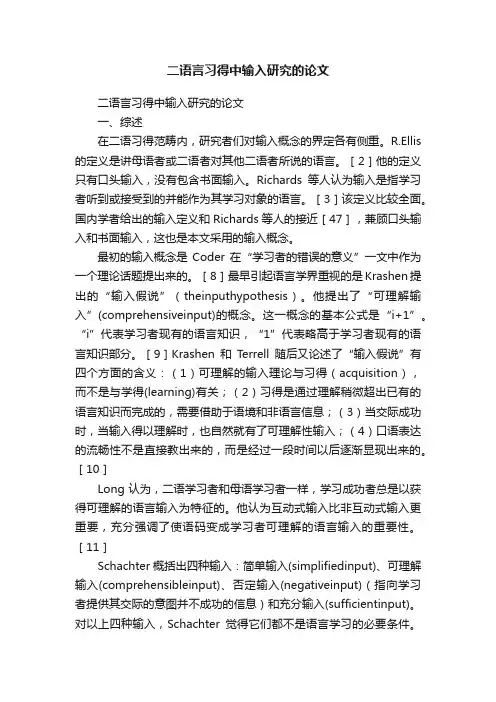
二语言习得中输入研究的论文二语言习得中输入研究的论文一、综述在二语习得范畴内,研究者们对输入概念的界定各有侧重。
R.Ellis 的定义是讲母语者或二语者对其他二语者所说的语言。
[2]他的定义只有口头输入,没有包含书面输入。
Richards等人认为输入是指学习者听到或接受到的并能作为其学习对象的语言。
[3]该定义比较全面。
国内学者给出的输入定义和Richards等人的接近[47],兼顾口头输入和书面输入,这也是本文采用的输入概念。
最初的输入概念是Coder在“学习者的错误的意义”一文中作为一个理论话题提出来的。
[8]最早引起语言学界重视的是Krashen提出的“输入假说”(theinputhypothesis)。
他提出了“可理解输入”(comprehensiveinput)的概念。
这一概念的基本公式是“i+1”。
“i”代表学习者现有的语言知识,“1”代表略高于学习者现有的语言知识部分。
[9]Krashen和T errell随后又论述了“输入假说”有四个方面的含义:(1)可理解的输入理论与习得(acquisition),而不是与学得(learning)有关;(2)习得是通过理解稍微超出已有的语言知识而完成的,需要借助于语境和非语言信息;(3)当交际成功时,当输入得以理解时,也自然就有了可理解性输入;(4)口语表达的流畅性不是直接教出来的,而是经过一段时间以后逐渐显现出来的。
[10]Long认为,二语学习者和母语学习者一样,学习成功者总是以获得可理解的语言输入为特征的。
他认为互动式输入比非互动式输入更重要,充分强调了使语码变成学习者可理解的语言输入的重要性。
[11]Schachter概括出四种输入:简单输入(simplifiedinput)、可理解输入(comprehensibleinput)、否定输入(negativeinput)(指向学习者提供其交际的意图并不成功的信息)和充分输入(sufficientinput)。
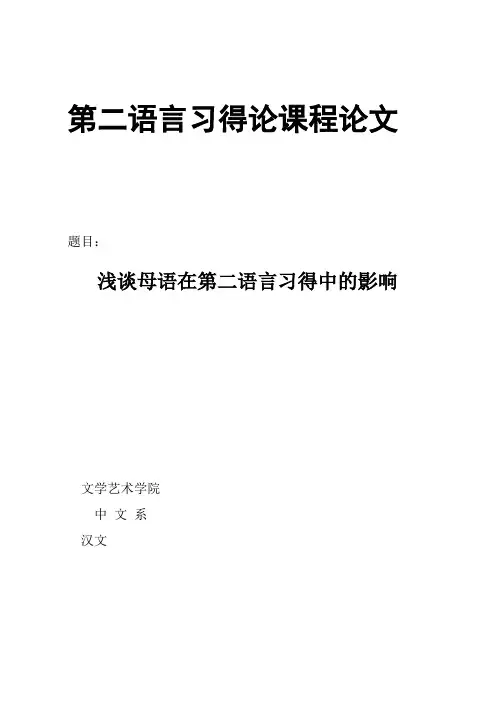
第二语言习得论课程论文题目:浅谈母语在第二语言习得中的影响文学艺术学院中文系汉文浅谈母语在第二语言习得中的影响我们都知道,任何事情都有两面性,有利也有弊,有积极的影响,也总会有消极的影响,母语在第二语言习得中的作用也是这样的。
这也就是学术界对于母语在第二语言习得中的影响一直存在着争议的原因。
大多数学者认为母语在第二语言习得中起着阻碍和干扰的作用,结合我们在第二语言学习中遇到的困难,的确证实了母语对第二语言习得中的干扰性和阻碍性。
但同时,我们不能因为母语在第二语言习得中的这些消极的阻碍和干扰就全盘的否定其在第二语言习得中的积极推动作用。
母语对第二语言习得的消极作用是非常明显的,这主要体现在以下的几个方面。
第一,在第二语言学习的过程中,我们经常受我们母语中的思维习惯的影响来表达和运用所学的语言知识,这就使得我们经常将第二语言母语化的倾向,为我们的学习带来消极的影响。
这主要体现在不同的文化背景下,我们的思维习惯不尽相同,很多我们习以为常的习惯和方式等,在另一文化背景下则显得不能接受和匪夷所思。
以英语和汉语的问候和寒暄习惯来说,中国人打招呼习惯问“你吃了吗?”,习惯谈论稍稍涉及隐私的诸如家庭,经历等话题,而英国人多谈论天气之类的话题,家庭经历等被视为禁忌。
这样就给我们的第二语言学习带来消极的影响,若是想将这种消极的影响降低,就必然增加了我们学习的负担。
当然,这种阻碍和影响也迫使我们拓展了知识,所以,也有它积极的一面。
第二,母语中的语法规和习惯也给第二语言的习得带来了一定的阻碍和影响。
这一影响在第二语言的学习中的消极影响最显而易见,也最为严重。
语法的规则和习惯很容易给第二语言的学习带来理解上的困惑和偏差,还是拿汉语和英语为例。
汉语和英语的语法在总体上非常相近,都是主谓宾等的基本语序,然而,汉语除了最基本的语法外,还经常有变式,如名词动用,宾语前置等,而且,汉语区分音节,这样就给以英语为母语的学习者在学习汉语时带来了诸多困难和阻碍;再拿英语来说,除了和我们的母语汉语较为相近的内容外,英语还有各种从句,是我们从未接触的,若是再用我们的母语进行学习的迁移,就会在理解上造成巨大的偏差,同样给第二语言的学习带来了阻碍。
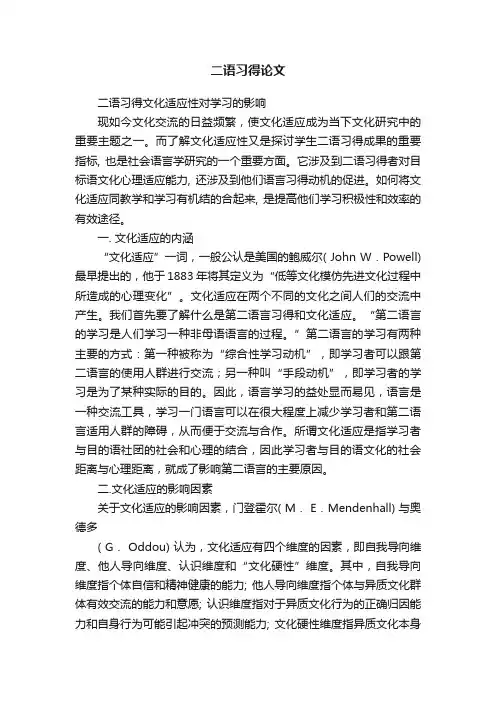
二语习得论文二语习得文化适应性对学习的影响现如今文化交流的日益频繁,使文化适应成为当下文化研究中的重要主题之一。
而了解文化适应性又是探讨学生二语习得成果的重要指标, 也是社会语言学研究的一个重要方面。
它涉及到二语习得者对目标语文化心理适应能力, 还涉及到他们语言习得动机的促进。
如何将文化适应同教学和学习有机结的合起来, 是提高他们学习积极性和效率的有效途径。
一. 文化适应的内涵“文化适应”一词,一般公认是美国的鲍威尔( John W.Powell) 最早提出的,他于1883 年将其定义为“低等文化模仿先进文化过程中所造成的心理变化”。
文化适应在两个不同的文化之间人们的交流中产生。
我们首先要了解什么是第二语言习得和文化适应。
“第二语言的学习是人们学习一种非母语语言的过程。
”第二语言的学习有两种主要的方式:第一种被称为“综合性学习动机”,即学习者可以跟第二语言的使用人群进行交流;另一种叫“手段动机”,即学习者的学习是为了某种实际的目的。
因此,语言学习的益处显而易见,语言是一种交流工具,学习一门语言可以在很大程度上减少学习者和第二语言适用人群的障碍,从而便于交流与合作。
所谓文化适应是指学习者与目的语社团的社会和心理的结合,因此学习者与目的语文化的社会距离与心理距离,就成了影响第二语言的主要原因。
二.文化适应的影响因素关于文化适应的影响因素,门登霍尔( M. E.Mendenhall) 与奥德多( G. Oddou) 认为,文化适应有四个维度的因素,即自我导向维度、他人导向维度、认识维度和“文化硬性”维度。
其中,自我导向维度指个体自信和精神健康的能力; 他人导向维度指个体与异质文化群体有效交流的能力和意愿; 认识维度指对于异质文化行为的正确归因能力和自身行为可能引起冲突的预测能力; 文化硬性维度指异质文化本身的开放度,这涉及到文化距离等因素。
在文化适应的情感因素方面,除个体好恶之外,较为显著的影响因素是社会支持。

输入假说在对外汉语词汇教学应用中的启示和反思摘要:克拉申的“输入假说”“输入假说”对我国的对外汉语教学研究有重要的参考价值,但如何真正将理论研究有效运用于课堂词汇教学仍然是尚未完全解决的问题,对输入假说的研究与分析有助于了解和提高对外汉语课堂词汇教学的质量。
本文回顾和分析了输入理论概念,介绍了对对外汉语词汇教学的启示,以及在应用中的几点反思。
关键词:输入假说,对外汉语,词汇教学,启示,反思1、引言斯第芬.克拉申,在20世纪80年代初提出了第二语言习得理论的五大假说,即习得与学习假说、自然顺序假说、监控假说、输入假说以及情感过滤假说。
在这五大假说中,克拉申本人认为最有意义的概念是输入假说,因为它试图回答语言究竟是如何获得的,以及用何种方式接触语言才能最有效的促进语言习得这个重大问题。
他的理论对我国第二语言习得研究产生了深刻的影响,但如何真正将理论研究有效运用于课堂教学仍然是尚未完全解决的问题,对输入假说的研究与分析有助于了解和提高对外汉语课堂词汇教学的质量。
现在公认的语言的概念是:“语言是一种用于人类交流的符号系统。
”它相当于一整套密码系统,操同一语言的人使用的是同一个密码系统,所以能够互相理解,但密码本身并不是惟一的、客观的,而是任意的、主观的。
每一种语言对同一事物都有不同的代码。
掌握一门语言,也就是掌握一个密码系统。
语言作为一个密码系统,可分为两部分,即词义部分和逻辑关系部分,也就是词汇和语法。
词义或词汇方面,我们在第一语言习得过程中已经自然地掌握了母语的一套符号系统,就好像用母语把我们身边世界中的每一样东西都标上了标签,每一样东西,不管是具体的还是抽象的,都有了自己的一个代号,名字。
然后,当我们思考的时候,我们头脑中所出现的每一个词汇都自然而然地代表着现实或抽象世界中的某一样东西。
我们就要将这种密码系统运用输入假说的积极方面与词汇教学相连接。
2、克拉申的输入假说理论概述输入假说认为,当一个人接受第二语言输入时,他按照“自然顺序”改进学习并取得高于他原有语言能力的进步。
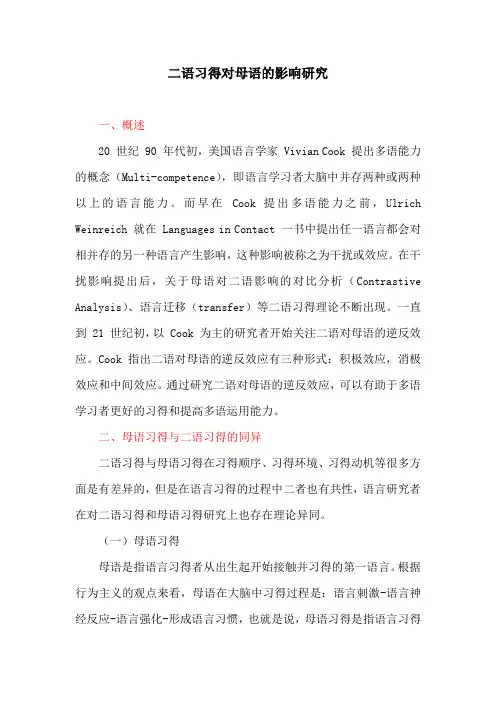
二语习得对母语的影响研究一、概述20 世纪 90 年代初,美国语言学家 Vivian Cook 提出多语能力的概念(Multi-competence),即语言学习者大脑中并存两种或两种以上的语言能力。
而早在Cook 提出多语能力之前,Ulrich Weinreich 就在 Languages in Contact 一书中提出任一语言都会对相并存的另一种语言产生影响,这种影响被称之为干扰或效应。
在干扰影响提出后,关于母语对二语影响的对比分析(Contrastive Analysis)、语言迁移(transfer)等二语习得理论不断出现。
一直到 21 世纪初,以 Cook 为主的研究者开始关注二语对母语的逆反效应。
Cook 指出二语对母语的逆反效应有三种形式:积极效应,消极效应和中间效应。
通过研究二语对母语的逆反效应,可以有助于多语学习者更好的习得和提高多语运用能力。
二、母语习得与二语习得的同异二语习得与母语习得在习得顺序、习得环境、习得动机等很多方面是有差异的,但是在语言习得的过程中二者也有共性,语言研究者在对二语习得和母语习得研究上也存在理论异同。
(一)母语习得母语是指语言习得者从出生起开始接触并习得的第一语言。
根据行为主义的观点来看,母语在大脑中习得过程是:语言刺激-语言神经反应-语言强化-形成语言习惯,也就是说,母语习得是指语言习得者根据特定语言符号或音源对大脑语言神经的刺激能够发出相应的语言反应。
从行为主义观点看来,语言的习得主要靠语言源的输入刺激和语言神经的吸收输出,但是母语习得者在最初输出的不是输入语言的全部,有的只输出10%,并且表示抽象概念、感情的体验是无法直接刺激语言神经。
所以行为主义认为母语习得在大脑中只是以语言神经的吸收和输出理论是有局限性的。
乔姆斯基为代表的语法天生主义学家认为,每个学习者都天生带有一套语言习得机制(LAD),在这套机制里语言习得者遵循着母语的普遍语法法则去完善母语习得。
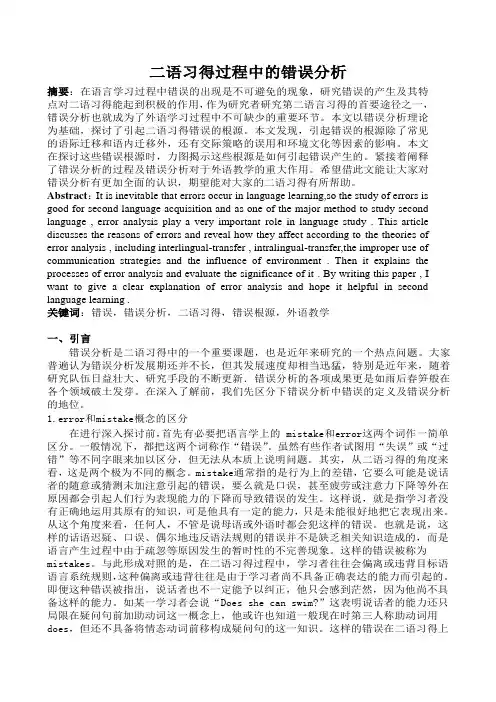
二语习得过程中的错误分析摘要:在语言学习过程中错误的出现是不可避免的现象,研究错误的产生及其特点对二语习得能起到积极的作用,作为研究者研究第二语言习得的首要途径之一,错误分析也就成为了外语学习过程中不可缺少的重要环节。
本文以错误分析理论为基础,探讨了引起二语习得错误的根源。
本文发现,引起错误的根源除了常见的语际迁移和语内迁移外,还有交际策略的误用和环境文化等因素的影响。
本文在探讨这些错误根源时,力图揭示这些根源是如何引起错误产生的。
紧接着阐释了错误分析的过程及错误分析对于外语教学的重大作用。
希望借此文能让大家对错误分析有更加全面的认识,期望能对大家的二语习得有所帮助。
Abstract:It is inevitable that errors occur in language learning,so the study of errors is good for second language acquisition and as one of the major method to study second language , error analysis play a very important role in language study . This article discusses the reasons of errors and reveal how they affect according to the theories of error analysis , including interlingual-transfer , intralingual-transfer,the improper use of communication strategies and the influence of environment . Then it explains the processes of error analysis and evaluate the significance of it . By writing this paper , I want to give a clear explanation of error analysis and hope it helpful in second language learning .关键词:错误,错误分析,二语习得,错误根源,外语教学一、引言错误分析是二语习得中的一个重要课题,也是近年来研究的一个热点问题。
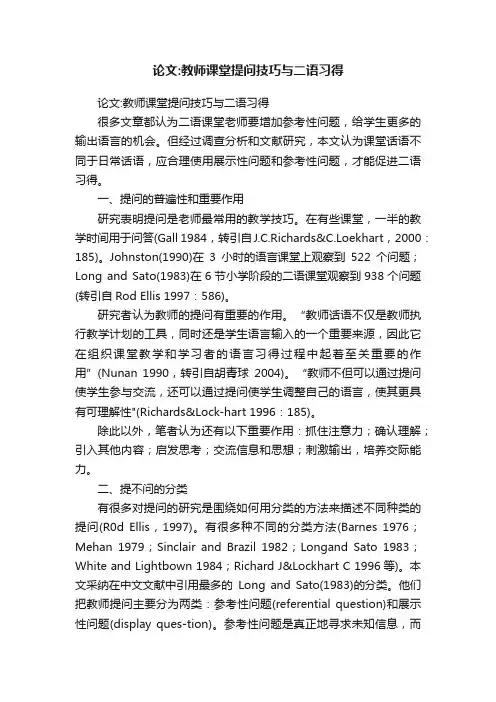
论文:教师课堂提问技巧与二语习得论文:教师课堂提问技巧与二语习得很多文章都认为二语课堂老师要增加参考性问题,给学生更多的输出语言的机会。
但经过调查分析和文献研究,本文认为课堂话语不同于日常话语,应合理使用展示性问题和参考性问题,才能促进二语习得。
一、提问的普遍性和重要作用研究表明提问是老师最常用的教学技巧。
在有些课堂,一半的教学时间用于问答(Gall 1984,转引自J.C.Richards&C.Loekhart,2000:185)。
Johnston(1990)在3小时的语言课堂上观察到522个问题;Long and Sato(1983)在6节小学阶段的二语课堂观察到938个问题(转引自Rod Ellis 1997:586)。
研究者认为教师的提问有重要的作用。
“教师话语不仅是教师执行教学计划的工具,同时还是学生语言输入的一个重要来源,因此它在组织课堂教学和学习者的语言习得过程中起着至关重要的作用”(Nunan 1990,转引自胡青球2004)。
“教师不但可以通过提问使学生参与交流,还可以通过提问使学生调整自己的语言,使其更具有可理解性"(Richards&Lock-hart 1996:185)。
除此以外,笔者认为还有以下重要作用:抓住注意力;确认理解;引入其他内容;启发思考;交流信息和思想;刺激输出,培养交际能力。
二、提不问的分类有很多对提问的研究是围绕如何用分类的方法来描述不同种类的提问(R0d Ellis,1997)。
有很多种不同的分类方法(Barnes 1976;Mehan 1979;Sinclair and Brazil 1982;Longand Sato 1983;White and Lightbown 1984;Richard J&Lockhart C 1996等)。
本文采纳在中文文献中引用最多的Long and Sato(1983)的分类。
他们把教师提问主要分为两类:参考性问题(referential question)和展示性问题(display ques-tion)。
第二语言习得与学得的特征及作用论文第二语言习得与学得的特征及作用论文摘要:习得和学得在第二语言学习中的教育方式、学习场所、学习教材、学习意识等方面存在不同特征,运用上要注意把握好外因与内因、形式与内容、感性与理性认识、归纳与演绎的关系。
关键词:辩证;第二语言;习得;学得一、习得与学得的特征及作用的异同(一)相同特征习得和学得都是人作为主体在学习语言。
众所周知,人天生具有语言的本能,人的语言知识包括两个方面:一方面指的是全人类语言所共有的,称为普遍语法;另一方面指的是各民族语言所特有的,称为个别语法。
普遍语法是人类通过生物进化和遗传先天获得的。
所以,无论是自然中的外语习得者,还是课堂上的外语学习者都可以通过普遍语法获得母语以外的第二种语言,即语言获得机制都在起作用。
习得和学得都是对母语以外的第二语言的学习。
第二语言学习者都是掌握了第一语言系统的人,其认知系统已发展完善,已拥有一套成熟的解决问题的方法。
当面对学习任务时;他们便运用这套系统对语言进行分析、类比,形成假设和检验假设等有意识的思维活动。
根据母语的掌握来学习第二语言,并根据语言数据不断地对假设进行肯定、否定或修正。
(二)不同特征1.传授教育方面第二语言习得过程中,对小孩子来说,其最重要的老师是父母,其次是小朋友,再次是社会。
对于成人来说,就没有比较固定的老师了。
而在学校学得方面,在学校获得第二语言,从时间、教师、目标、测试等各个方面来看是非常规范的。
这是学校进行语言教学的一个显著特点。
在中国,从小学至大学,凡是语言教学,都有自己一整套的规范,保证了学校语言教学的规范性。
2.学习场所第二语言的自然习得没有固定的课堂,只要进行交际就是课堂。
不会因为时间和空间的限制而受到影响,相反,正是特定的时间和空间发生的交际活动,促进了第二语言习得者的言语经验知识积累。
也正是特定的时间和空间发生的交际活动,形成了第二语言习得者熟练的言语生成能力。
他们的语言能力是在大量以信息交流作为目的的真实交际活动中形成的。
二语习得的论文1. 引言二语习得是指人们在掌握第一语言(母语)之后学习和习得第二语言(非母语)的过程。
对于许多人来说,学习第二语言是一项重要的任务,无论是为了适应国际交流的需要,还是为了获得更广阔的职业发展机会。
本文将探讨二语习得的理论基础、习得过程中的关键因素以及有效的学习策略。
2. 二语习得的理论基础2.1 习得假设二语习得的理论基础之一是习得假设。
习得假设认为,人类习得第二语言的过程类似于母语习得过程,即通过与他人的交流和使用语言的实践来逐渐掌握第二语言。
这与传统的语法翻译法有所不同,后者强调语法规则和词汇的规则性学习。
2.2 自然顺序假设自然顺序假设认为,在学习第二语言的过程中,不同语言的特点和语法规则会按照一定的顺序被习得。
研究表明,学习者常常先掌握第二语言中最常用的词汇和基本的语法结构,然后逐渐习得更复杂的语言现象。
这一假设对于教学的组织和设计具有指导意义。
2.3 输出假设输出假设认为,通过积极参与口语和书面交流,学习者可以提高第二语言的习得水平。
这一假设强调了实际使用语言的重要性,鼓励学习者积极参与沟通活动,不断提升语言表达能力。
3. 二语习得的关键因素3.1 学习者个体差异个体差异是影响二语习得过程的一个重要因素。
不同个体在学习能力、学习策略和学习态度方面存在差异,这些差异会影响他们对第二语言习得的效果和速度。
3.2 输入环境输入环境指学习者接触和使用第二语言的环境。
一个良好的输入环境可以提供大量的语言输入和真实的语言交流机会,有利于学习者的语言习得过程。
3.3 学习者动机和情感因素学习者的动机和情感状态对二语习得过程有着重要影响。
积极的动机和积极的情感状态有助于提高学习者的学习兴趣和投入度,从而促进他们的语言习得。
4. 有效的学习策略4.1 意识化学习策略意识化学习策略是指通过有意识地关注语言的形式和结构,来提高语言习得效果的策略。
学习者可以通过分析语言现象、记忆规则和词汇等方式,加深对语言的理解和掌握。
第二语言习得心理学方向研究综述摘要:本文关注点是第二语言习得研究,通过阐述第二语言习得研究现状,描述第二语言习得研究在心理学方向的研究成果,从认知加工研究范式、目的语在第二语言习得研究中的迁移以及第二语言阅读中元认知展望心理学方向第二语言习得研究的未来和发展。
关键词:第二语言习得认知加工迁移元认知正文一、关于第二语言习得研究现状我国的第二语言习得研究可以说正在处于起步阶段,无论是在对外汉语教学领域还是外语教学领域,都已经有研究者开始了第二语言习得的研究。
在对外汉语教学领域,这些研究主要集中在外国人学习汉语的偏误分析、中介语研究、第二语言习得过程、语言能力结构等(有关综述见王建勤,1997);在外语教学领域,第二语言习得研究主要包括影响第二语言习得的社会因素和个人因素(特别是学习风格、学习策略)等方面的研究。
这些研究为国内开展第二语言习得研究奠定了基础。
但是,与国外的研究相比,我们这方面的研究还比较薄弱。
无论是在研究范围还是在研究方法上,我们与国外的差距都比较大。
进入21世纪以来,研究范围开始拓展到语言学、心理学、心理语言学、语用学、社会语言学等众多的方面。
早在20世纪时,桂诗春和宁春岩(1997)就对1993-1995年国内四种外语期刊《外语教学与研究》《外国语》《外语界》《现代外语》中的755篇文章进行了一次分类统计,发现思辨性研究所占的比例(54%)最大,其次是描述性研究(20%)、介绍性研究(13%)和理论性研究(10%),实验性研究所占比例最小,仅为3%,即在755篇文章中仅有24篇采用实验研究方法。
并且他们还发现80%的研究没有数据,12%的研究虽有数据但无统计分析,有统计分析数据的研究只占7%。
根据这次的统计结果我们可以看出国内对于第二语言习得的研究亟待解决研究方法的更新问题。
随着国内刊物对文章要求的提高,思辨性研究比例在减少,但是依然面临着很大压力。
一般来说我们研究方法可以分为定性和定量两大类,定性研究的主要特征有:1随着研究的进展逐渐形成假设;2通过自然的观察和访谈收集资料;3资料来源于自然情境;4对资料进行叙述、描述;5研究一个或者少数几个案例。
137364 学科教育论文论二语习得与外语教学一、第二语言习得的理论基础1.1行为主义行为主义认为:语言的习得是通过模仿与不断的重复对刺激的反应,从而所形成的习惯。
就第二语言习得而言,在这些形成的习惯中,对习得第二语言有益的我们称之为正迁移,反之,阻碍第二语言习得的习惯,我们称之为负迁移或者干扰。
此外,行为主义学派还提出了著名的“对比分析理论”,即通过对第一语言以及第二语言中的语音,语法,词汇等方面做系统的比较与分析,得出两者间的差异,从而预示学习者在学习第二语言时可能面临的困难,并在学习过程中有意识地克服这些困难,形成良好的学习习惯,进行有效的第二语言习得。
1.2认知语言学认知语言学派反对语言习得是人类生来固有的机制,语言的习得与人类的经验密不可分。
认知语言学重视二语习得者对于语言习得的主观能动性和目的性,反对机械,盲目地学习,这一点对于指导语言教学有相当重要的参考价值。
它启示我们在指导学生进行第二外语习得时,应想方设法运用多种多样的教学形式来调动学习的主观能动性,培养学生的认知兴趣和探究倾向,使语言习得者在积极主动的心向指引下进行第二语言的习得。
1.3心理语言学心理语言学与认知语言学的基本观点大致相同。
但是认知语言学更注重的是在第二语言习得的实践过程中,有可能出现的实际问题,并从中寻找规律。
而心理语言学则是重在从理论上论述第二语言习得的认知属性及依据。
心理语言学认为:注意力与记忆的一般机制与熟练掌握第二语言有密不可分的关系。
当学习者有意识地注意某些单词或语言结构时,有助于其长期的习得与记忆。
反之,倘若学习者对语言不加以注意的话,经过不断地强化,最多只能短期地习得,很容易遗忘。
1.4社会语言学社会语言学与第二外语习得的关系跟心理语言学的略有不同。
社会语言学与第二外语习得的研究是密切合作的,息息相关的。
社会语言学强调社会环境和交际对象与语言习得者相互交流的重要性。
因此,社会语言学主张将第二语言放到特定的语言环境下学习,联系学习者的生活实际进行教学,这样有利于学习者更为有效地习得语言。
英语语言学方面论文(2)英语语言学方面论文篇3浅析语言学习中的英汉对比论文关键词:语言学习母语正迁移母语负迁移论文摘要:在二语学习中,学习者的母语会对二语习得产生独特的影响,因此在语言的学习中,要针对其特点,采取对应的方法。
英汉对比教学和学习能有效地降低语言学习中的母语负迁移,更好地发挥母语的正迁移作用。
1 引言二语习得过程中,母语会不可避免地对学习者产生一定的影响。
母语和二语之间的相似之处会促进语言的学习,此现象为母语正迁移;而不同之处将阻碍语言的学习,此现象被称之为母语负迁移。
学习者要有意识地发挥其有利的影响,降低其不利影响。
因此英汉对比研究对二语习得是非常必要的。
2 英汉对比学习的理论依据在二语习得过程中,母语会产生迁移作用,这是被语言学家所证实的事实。
Odlin(2001)这样定义语言迁移,它是一种跨语言的影响,这种影响是由学习者先前习得的语言和目标语之间的相似和差异引起。
语言之间的相似之处有助于二语的习得,这种影响称之为正迁移,而语言之间的差异会阻碍二语的习得,称之为负迁移。
在二语习得过程中,先前习得的语言,一般是母语,已经有了完善的知识结构和牢固的基础,这一特点给二语习得带来的既有积极的作用,同时也会产生负面的影响。
如何发挥其积极作用,减少负面影响是语言学习者有效提高语言学习效率的重要方面。
因此英汉不同之处的对比就变得尤为重要。
3 英汉对比的方面3.1 本体对比3.1.1 大小写方面在汉语中,我们不用考虑汉字的大小写,因为汉字不存在大小写的区别。
而英语的字母则不同,有大小写之分。
以汉语为母语的学习者,由于大小写概念不强,母语的不区分大小写的印象又很深,因此很容易在此方面出错。
英语中一个句子的首字母是必须要大写的,还有一些专有名词,如地名,人名,书名等。
3.1.2 标点符号英汉语在标点上有些是不同的,如句号的写法。
英语是一个实心的圆点,而汉语是一个圆圈。
汉语中有书名号,英语中用引号,或斜体不加标点。
第二语言语用习得研究对外语教学的启示论文关于第二语言语用习得研究对外语教学的启示论文论文关键词:语用习得;丈化意识;外语教学论文摘要:二语习得过程中的语用能力的发展问题正受到研究者的关注。
二语语用能力的发展受多种因素的影响,如语法能力,语言迁移以及学习者地位和社会交往等。
本文探讨了在课堂环境下二语语用能力的培养,涉及到课堂语用知识的可教性和语用精入,重视个体的发展和文化意识的培养,目的在于帮助学习者在语言交际中强化语用意识,提高语言能力。
一、引言20世纪80年代Canale&Swain的研究成果(第二语言教学与测试中交际模式的理论基础》标志着二语语用习得研究新领域的开始。
在这个研究领域中,Ellis(1994)在《第二语言习得研究》一书中总结了当时的语用习得研究,指出了在语用能力发展过程中的三个重要因素,即学习者的语言能力,语用迁移以及学习者的地位和社会交往。
在Ellis的研究之后,Kasper&Rose(1999,2001)等将二语习得和语用学研究紧密结合起来,关注二语习得研究过程中的认知特性,从理论和方法两方面就二语/外语语用习得和语用能力发展做出新的系统研究成果。
国内学者如何自然等(2003)也提出了外语教学的语用路向,即外语教学中的语用学方法论。
随着语用习得研究的深人,语用能力的培养已成为语言教学的焦点之一。
本文希望通过对语用习得的探讨重新审视外语教学的视角,在教学过程中重视对学生语用能力的培养,强化语用意识,提高学生的语言交际能力。
二、影响二语语用能力发展的因素(一)语法因素Ellis(1994)认为学习者的语法水平是其语用能力发展的基础,很多研究者也赞同这一观点。
但是也有研究者对此观点提出质疑,认为语法水平高未必语用能力就强。
持这种观点的研究者认为,有的学习者虽然了解某种语言形式,但是却不能在真实语境下恰当地使用这种语言形式。
Bardovi-HarligandDornyei(1998)和Niezgoda&Rover(转自Kasper,2001)对EFL和ESL两类学习者的语用和语法认知程度以及两者的相关性试验研究发现,ESL学生具有更强的语用意识,认为语用错误比语法错误更严重,而EFL学生正相反;通过对语言水平较高的学习者语用能力的检测,发现试验的结果始终是一致的:语法能力和语用能力并非正相关,即语法能力高并不一定保证语用能力高。
二语习得之
认知研究及其模式
班级:13012班
学号:
姓名:
析二语习得之认知研究及其模式
前言:有关第二语言的习得研究,最早可以追溯到上个世纪的40年代,当时其研究目的主要是出于语言教学实践的需要,其方法论基础是结构主义,研究方法主要是对比分析。
现在,语言习得研究已经成为语言学,心理语言学,认知心理学,计算语言学和语言教育学共同关心的多学科交叉的课题。
摘要:语言的认知研究包括第一语言的研究。
熟悉和掌握认知心理模式,对于建立和熟练运用教学范式与学习方式,有着重要的意义。
关键词:二语习得,认知研究,研究方法,认知模式
正文:语言的认知研究包括第一语言的研究,也包括第二语言的研究。
第二语言习得研究是20世纪60年代末新兴的学科领域,该领域主要研究第二语言习得的本质和习得的过程。
它的发,研究内容和研究方法与其他学科密切相关,例如心理学,语言学,社会学,人类学,心理语言学,社会语言学,和神经语言学等等。
第二语言习得的认知研究,强调的是认知心理学家的目标,即从心理表征和信息加工的角度探讨对第二语言知识进行接受,编码,操作,提取和使用的过程。
一.理论
人们研究第二语言习得,首先因为是一个具有重要理论价值的引人入胜的研
究课题。
实际上,了解和掌握一门第二语言,这本身就是一项了不起的认知活动,包含复杂的认知过程。
(一)语言本质的认知研究
对预言的形式,语言之间的关系进行详细的描写,是语言学家的任务。
这种描写对于建立一个完整的语言习得理论是必须的,但这样做远远不够。
认知语言学认为语言是建立在我们对世界的经验和表达基础上的。
一种语言中的词的意义以及使用上的搭配,取决于我们队周围世界的直觉和分类。
(二)语言发展的认知研究
关于语言发展即语言习得的本质问题,很多语言学家认为,人类语言能力取决于先天的普遍语法—限制语言发展。
语言学习的内容繁多复杂,因此语言学习和其他复杂的技能学习一样,需要大量的学习。
二.方法
无论认知科学取得多么大的进步,一定还有许多问题没有解决。
(一)观察法
如果我们想了解语言习得,首先我们要观察语言习得。
语言研究和语言学习一样,建立在手机自然情景中的自然交际材料基础上。
为了科学进步,我们需要能够共享语言数据的分析。
内省对语言学家,心理学家来说都不是一个很好的科学方法。
最好是观察行为而不是对某些理想化的能力进行推测,构想。
(二)实验法
认知心理学的先驱者之一George Miller 曾经开玩笑说:“我有一些朋友不相信人有两只手,两条腿,除非你做仪的实验来证明。
”当然这个说法有点过分。
如果我们想研究输入和练习在语言结构习得中的作用,那么我们需要适当记录学
习者的输入。
因此有一个传统,即在实验条件下,通过短时间的接触第二语言,外语或人工语言,研究语言习得的过程。
(三)模拟法
任何一个有价值的第二语言习得理论,都应包含多种变量,多个层面的交互作用,从社会语言学层面到生物学层面都有。
所以,浮现主义者倾向于用联结主义模拟系统探讨浮现的内在条件。
过去,进行连接注意研究都必须首先掌握计算机编程技能,现在情况有所改变。
只要会用stats软件包或复杂文字处理软件的人,都可以学会用这个程序。
下面我说一下二语习得的认知模式。
模式有很多种。
若果一一细讲,怕是永远讲不完的。
所以,在这里我只选择了认知模式里的一个方面—认知心理模式。
认知心理模式是学习过程中的内部心理活动程序,可以说是各种教学范式的内部运作。
熟悉和掌握认知心理模式,对于建立和熟练运用教学范式与学习方式,有着重要的意义。
其组成,包含下列一些认知元素:
(一)认知的理论基础
认知心理模式的形成,有其重要的意义。
其组成,包含下列一些认知元素:
(一)认知心理模式的形成,有其一定的生理基础和心理的基本原理,设计
感觉的作用,神经元的传递,大脑的记忆功能和输出功能等。
(二)认知的感知起点
认知心理模式必然有一个感知外界信息的七点,或是视觉是听觉等。
(三)认知目标
认知心理模式的运作,总会有一个目标。
这是实施某种认知心理模式所获得的结果。
(四)认知过程
就是认知的程序,也就是认知的感知起点和认知目标中间的环节和流程。
(五)认知手段和策略
运用认知心理模式达到理想的目标,必须采取一些必要的手段和策略。
掌握认知心理模式,可以产生形成各种教学范式和见血方式的建立,必须考虑语言学习和汉语学习的特点。
结语:通过用多种方法对语言本质及发展的认知研究,更清楚地了解了认知的理论基础,熟悉和掌握认知心理模式,对于建立和熟练运用教学范式与学习方式,有着重要的意义。
参考文献:
[1]丁言仁.2004.第二语言习得研究与英语学习[M].上海:上海外语教学出版社.
[2]文秋芳.2001.英语学习的成功之路[M]. 上海:上海外语教学出版社.
[3]崔刚.1994.布鲁卡氏失语症实例研究[J].外语教学与研究(5):272-33.
[4]桂诗春.2004.我国外语教学的新思考[J].外国语(4);229.
[5]黄远振.2001.词的形态理据与词汇习得的相关性[J].外语教学与研究.(6):430-435。